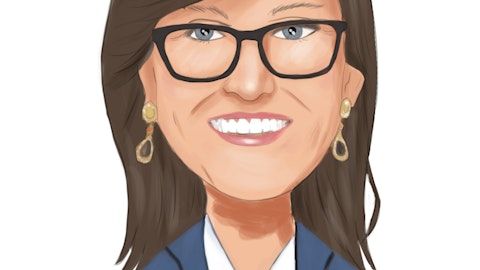Rob Painter: Next question.
Operator: Your next question comes from the line of Jason Celino from KeyBanc Capital Markets. Your line is open.
Jason Celino: Great and just one for me. This follows up on one of the other questions. When we think about B&I hardware and construction software, who are the typical decision-makers at your customers? Like are they separate budget decisions? How tight are those purchasing decisions between the two? I don’t know if that’s a good way of thinking about it.
Rob Painter: Hey Jason. Thanks for the question. I would say it depends on the size of the customer between the hardware and the software. And not surprisingly, in the small to mid-market, we are doing more with the C-levels of our customers. And then I would say the bigger the customer, the more it’s segmented across the company who is the economic buyer. Let me say something I think strategically your question unlocks is the nature of moving from selling more point solutions to selling connected offerings. Because what we do see happening as increasingly as you should make that shift from the point solution to the connected offering, you are doing more account-based selling. It is a fundamentally different approach on the go-to-market side of how we sell and who we sell to at our customers.
So, historically you might have had – you could have had the virtual design and construction department deciding on some technology, then they are going to use. You can have field crew deciding which hardware machine control or survey kit they want to use out in the field. As we move to these bigger offerings, the nature of that is actually, the dollar amount becomes higher even as we move this to – from the perpetual over to a subscription basis. And we see it from the uplift when we see, when we can bring customers who are already subscribing to us and now who are taking bigger part of the portfolio, we see where we get a multiple uplift. But naturally, as those dollar uplifts go higher, we are starting very often to work with the different set of people within the organizations and within our customers.
Now, that level often has already been using and been the customer at that ERP level because who is typically buying the ERP is going to be more of the CFO type who is buying that. So, now when you think about it, we are able to go to that person with the bigger offering. That’s a different sales motion for us. And so actually, we see that as a very positive thing for us, is changing the nature of the economic buyers when we are offering a solution.
Jason Celino: Well, the – I guess my quick follow-up here is the hardware weakness you are seeing. Is it mostly with the smaller customers who may not be as penetrated at Trimble, either on the hardware or software side?
Rob Painter: Oh, I see what you are asking. That’s a good question. I have to – let’s say let me think more about that and come back with a more data, a fact-based answer on that. We have been looking more at the nature of the end markets that are being served and those who do more residential work or infrastructure work. I mind you, many contractors do both kinds of work. If you are a civil contractor, you are – have to be buying more Trimble software that’s going to be set your business. If you are doing residential construction, you are doing more single-family construction, you are not buying a Trimble ERP. It’s too big for you if you are doing that kind of residential construction. By the time you are doing multifamily, there is a set of additional technology becomes more applicable. So, probably I am answering your question now as I talk about that out loud.
Jason Celino: Okay. Great. Thanks for the color.
Operator: Your next question comes from the line of Joshua Tilton from Wolfe Research. Your line is open.
Joshua Tilton: Hey guys. Thanks for sneaking me in here. My first question is kind of a high level one. But I think throughout the numerous answers to questions in the Q&A. You talked about the strength of the bundle that you guys have. It feels like with macro getting worse, like we hear about it in other software sectors, but now is the time when customers want to go all in on the bundle and kind of to achieve their software goals, save some money and drive an ROI. So, I guess my question is like why aren’t we seeing that offset some of the other weakness a little bit more? And maybe when should investors expect to see maybe the environment benefit demand for the attractive bundle that you guys sell?
David Barnes: Hi Josh, it’s David. First of all, I would say that we are seeing that in the software business where Rob mentioned the 30%-plus bookings in our construction software business, ARR is still really strong, growing at 20%. So, that business is benefiting from the clear path to value and Rob mentioned labor constraints that our construction customers have and software technology being needed. The hardware side is more – I will point out within B&I, our hardware is sold to civil contractors, so it’s a more narrow range of customers then buy our software. And the sale of our hardware for that segment is driven by, to use Rob’s, moving dirt. And while the infrastructure dollars are going up, if you take the inflation and back that out, labor and materials cost inflation, the actual amount of dirt being moved has not risen much over time, and that’s the fundamental driver of our B&I hardware business.
So, the demand of the actual – for technology to moving the earth isn’t – hasn’t grown as much as we had anticipated. But the need for productivity has grown and our software offerings are geared to meet that need, and that’s where we are seeing the growth.
Rob Painter: And Josh, just as it plays into seeing it, I think you are also asking about playing into the full Trimble financial model. One point of reference is after we announced the AGCO joint venture, when we said pro forma going forward, we would be over 70% software and 55% recurring. So, the law of the math I think should start to play through a little bit more as well.
Joshua Tilton: Super helpful. And then just a quick follow-up, I wanted to maybe to the extent that you guys can provide it, just any more color you can give us on the churn in the Mobility segment. It feels like when we talked about it in the past, it felt more like it was isolated to that specific order and now maybe it’s feeling just a tad more structural. Any more detail you guys can provide us there?
Rob Painter: I would say not structural. It would be – that would be the answer on the mobility churn.
Joshua Tilton: No problem. Thank you.
Operator: In the interest of time, our final question today comes from the line of Clarke Jeffries from Piper Sandler. Your line is open.
Clarke Jeffries: Hello. Thank you for taking the question. In interest of time, I will keep it to one. I think David may have answered a part of this, but I wanted to kind of further clarify. When you think about the B&I portfolio and the relationship between dollar growth in moving dirt, is it fair to say that a lot of the ARR products, you can still capture opportunity when projects are going through engineering and procurement, but stop at that shovel ready stage due to the input costs. I wanted to understand as we think about maybe the next 12 months and the cyclical factors in construction, ARR versus hardware and whether if more projects come into this sort of paradigm, what part of the portfolio might outperform?
Rob Painter: I would expect broad outperformance really across the board on the ARR side of the business from the feasibility work to the design, to the engineering, to the procurement, through the earthmoving itself, the software aspects of that, that are involved in that and through the operations and maintenance. So, the overall dollar amount of work is there.
Operator: This does bring us to the end of our Q&A session for today. I would like to thank our speakers for the presentation, and thank you all for joining us. This now concludes today’s conference. Enjoy the rest of your day. You may now disconnect.
Follow Trimble Inc. (NASDAQ:TRMB)
Follow Trimble Inc. (NASDAQ:TRMB)
Receive real-time insider trading and news alerts




